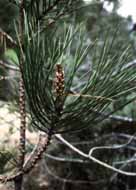
Branchlet and foliage on a tree in a young postfire stand [C.J. Earle, 7-Mar-1998]. |
Pinus attenuata
Lemmon 1892
Common NamesKnobcone pine (1).Taxonomic notesSyn: Pinus tuberculata Gordon 1849, not D.Don 1836; P. tuberculata var. acuta Mayr (1, 6).DescriptionTree: Tree to 24 m tall or, on very poor sites, a shrub; dbh to 80 cm, trunk usually straight; crown usually conic (1, 7).Bark: Purple-brown to dark brown, shallowly and narrowly fissured, with irregular, flat, loose-scaly plates, on upper sections of trunk nearly smooth (1). Branches: Ascending (1). Shoots: Slender, red-brown (1). Leaves: Three per fascicle, spreading or ascending, persisting 4-5 years, (8-)9-15(-20) cm × (1-)1.3-1.8 mm, straight or slightly curved, twisted, yellow-green, all surfaces with fine stomatal lines, margins serrulate, apex abruptly conic-subulate; sheath (1)1.5-2 cm, base persistent. Buds ovoid to ovoid-cylindric, dark red-brown, aging darker, ca. 1.5 cm, resinous; scale margins fringed, apex attenuate (1). Cones: remaining closed for 20 years or more, or opening on burning, in whorls, hard and heavy, very asymmetric, lanceoloid before opening, ovoid-cylindric when open, 8-16 cm, yellow-brown or pale brown, sessile or on a peduncle to 1 cm; maturing in 2 years (1, 7). Cone scales: Apophyses toward outside base increasingly elongate, mammillate or raised-angled-conic, downcurved near base, scarcely raised on branchlet side, rhombic; umbo central, low-pyramidal, sharp, upcurved (1). Pollen cones: Ellipsoid-cylindric, 10-15 mm long, orange-brown (1). Seeds: Compressed-oblique-obovoid; body ca. 6-7 mm, nearly black; wing narrow, to 20 mm. 2 n =24 (1). Wood: Similar species: RangeUSA: Oregon & California, specifically: "In the Coast Range maountains of southern Oregon and northern California (on the Siskiyou Mountains, Trinity Alps, Mount St. Helena Summit, etc.), on the Santa Cruz Mountains, on Point Pinos, near Carmel, Monterey County, and the eastern slopes of the Santa Lucia Mountains, Monterey County; on Mount Shasta (4000 to 5600 feet); on the west slopes of the northern Sierra Nevada, at 1500 to 4500 feet, south to the south side of the San Bernardinos at 2500 to 4000 feet. Lacking otherwise in the southern Sierra Nevada and southern Coast Ranges (5). See also (8). Also in Mexico: Baja California Norte. Fire successional on dry slopes and foothills (1).Big TreeDiameter 109 cm, height 36 m, crown spread 20 m, located in Shasta County, CA (2).OldestIn cultivation in Britain not known to exceed about 80 years (7).DendrochronologyEthnobotanyUSDA hardness zone 7 (inland Oregon origins), otherwise zone 8.ObservationsSeen only as an ornamental. Besides the specific range notes given above, Arno & Gyer (3) specify several locales around Yosemite National Park and it is also found in dry associations with Sequoia sempervirens at Redwood National Park (4).Remarks" Pinus attenuata , mostly a chaparral species, bears cones at an early age. Its seed crops are heavy, and a hot fire permits the seeds to be released. It forms hybrids with P.muricata and P. radiata " (1).
Citations(1) Kral in Flora of North America online .(2) American Forests 1996 . (3) Arno & Gyer 1973 . (4) ICE Flora and Fauna Database . (5) Peattie 1950 . (6) C.I. Millar 1986. The Californian closed-cone pines; a taxonomic history and review. Taxon 35: 657-670. (7) M.P. Frankis, personal communication 6-Mar-1999. (8) Robert S. Thompson, Katherine H. Anderson and Patrick J. Bartlein. 1999. Atlas of Relations Between Climatic Parameters and Distributions of Important Trees and Shrubs in North America. U.S. Geological Survey Professional Paper 1650 A&B. URL= http://greenwood.cr.usgs.gov/pub/ppapers/p1650-a/pages/conifers.html , accessed 22-Jan-2000.
See also:
This page co-edited with M.P. Frankis, Mar-1999. |
|
[ Pinus ] [ Pinaceae ] [ home ]
This page is from the Gymnosperm Database
|